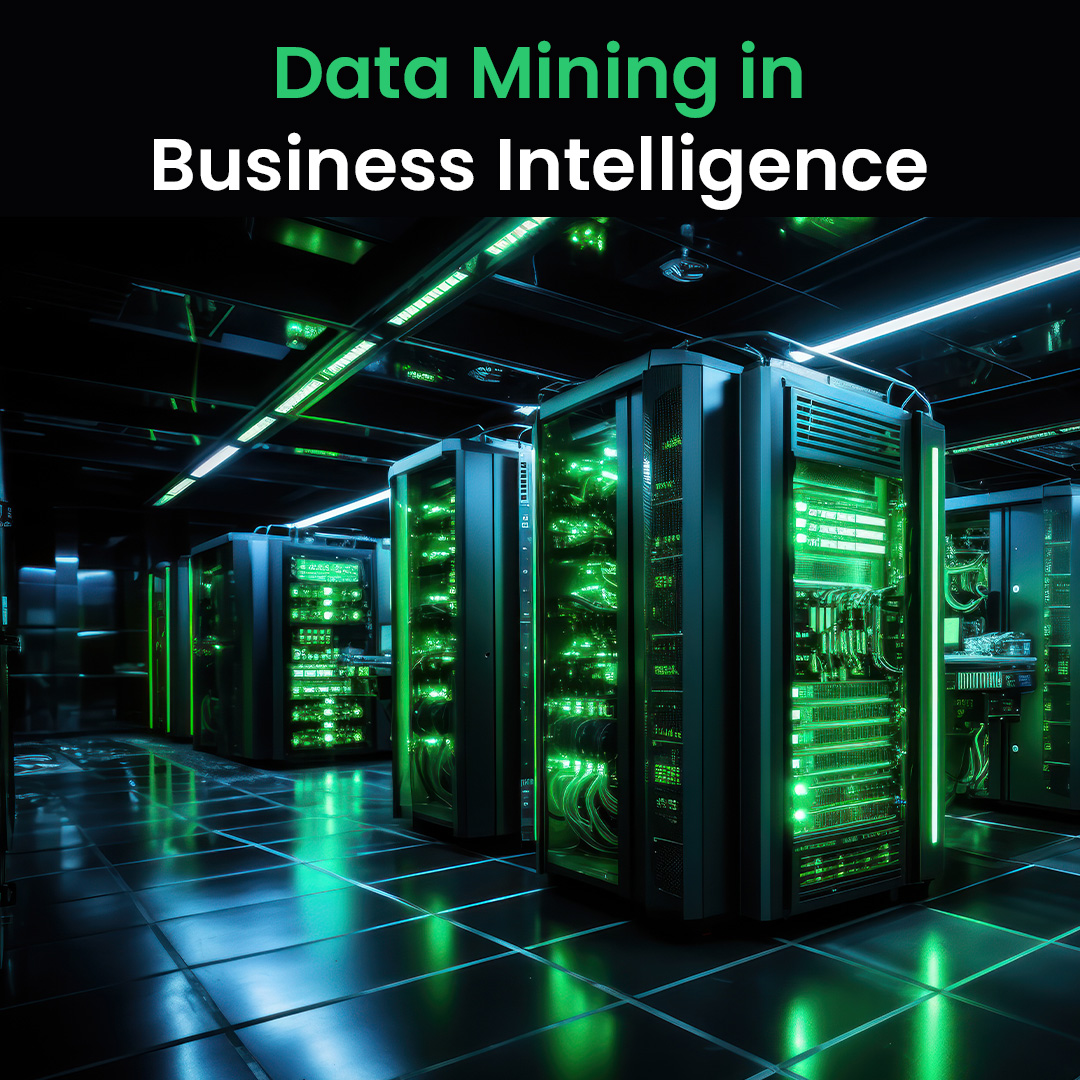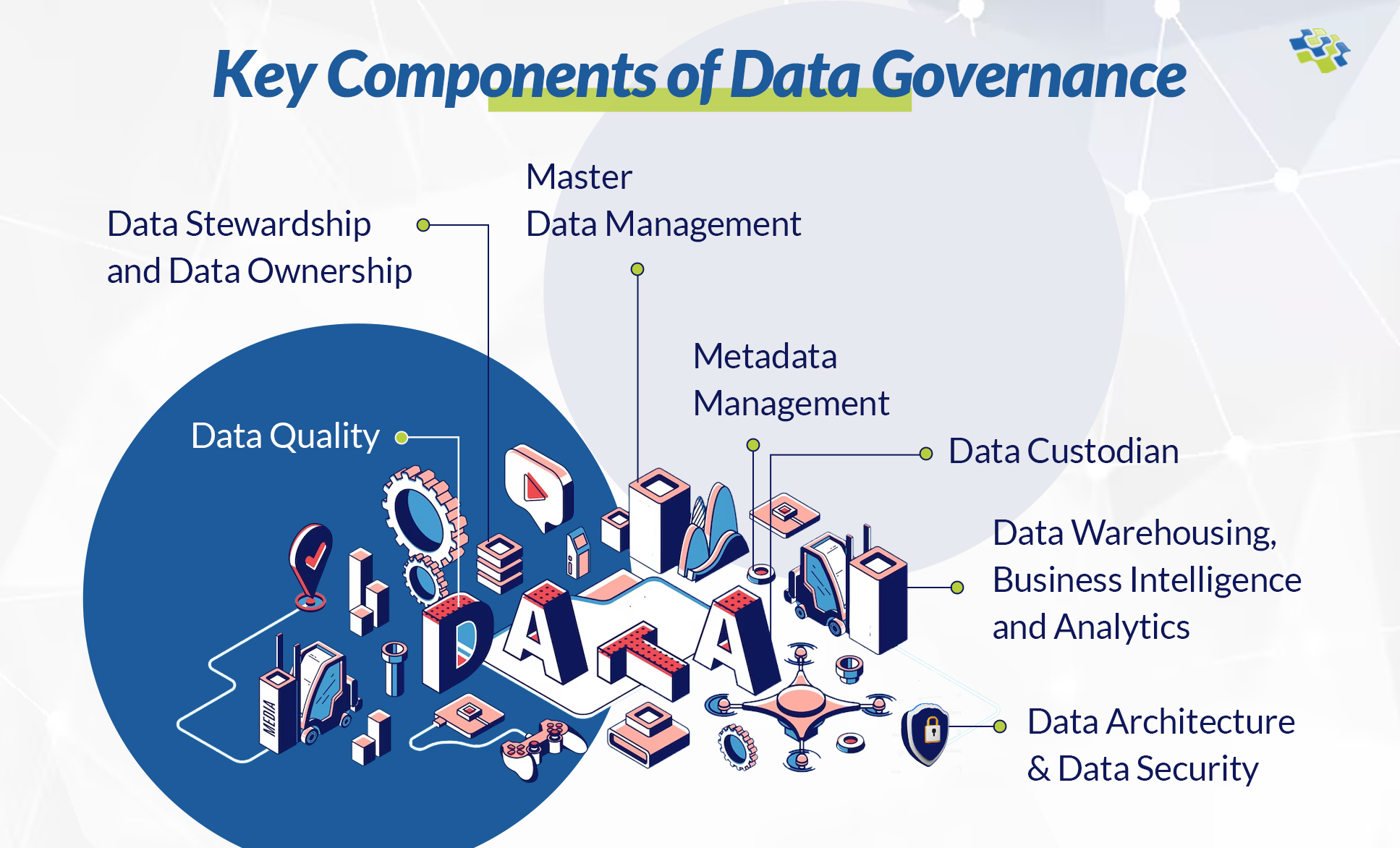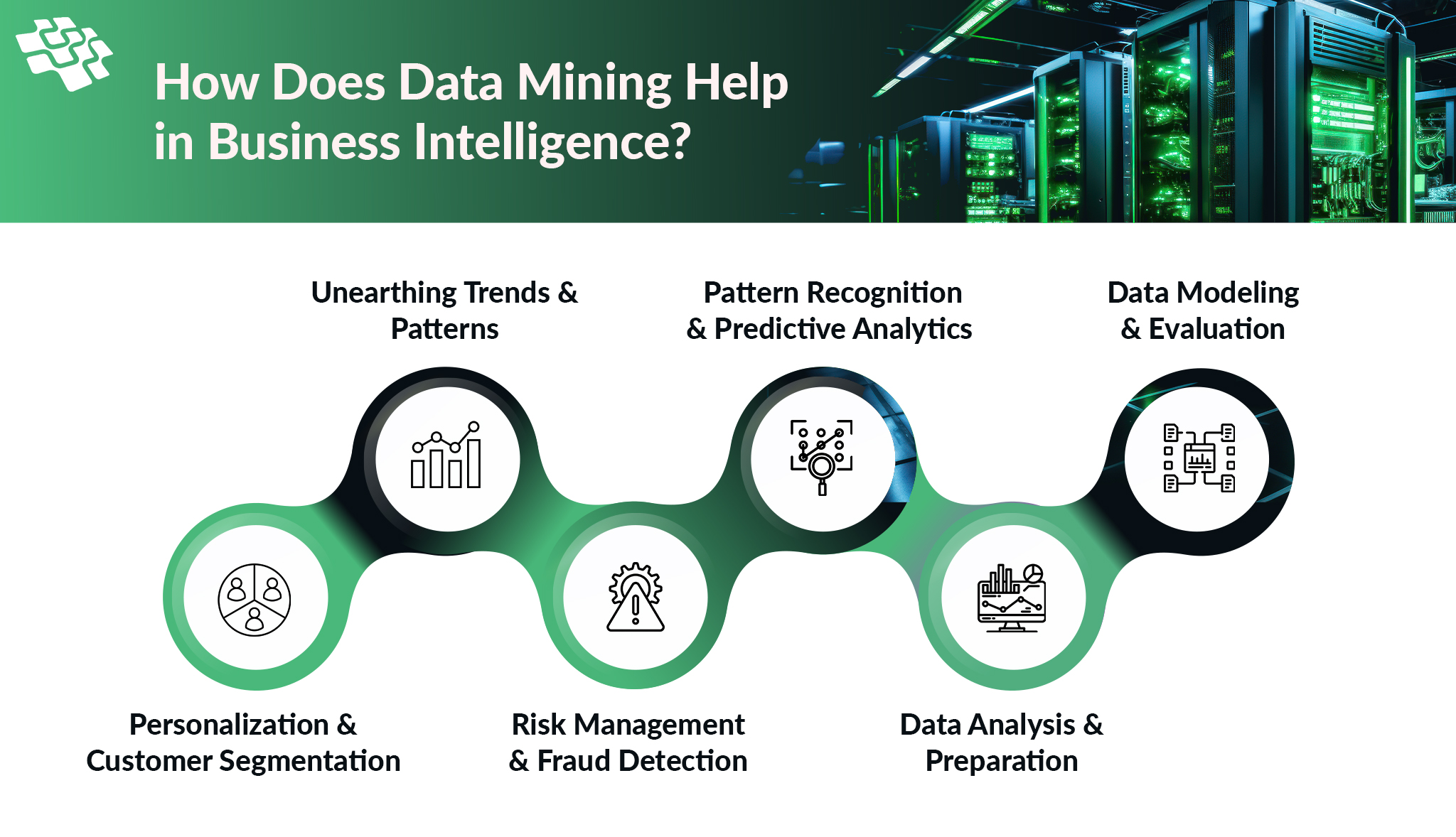Data Mining for Business Intelligence: How Can It Help?
This blog is devoted to executives and business owners looking to use data mining solutions for business intelligence. We’ll explore how data mining may support you in forecasting market trends, making well-informed decisions, and offering individualized client service.

Struggling with Data Silos? Our PhD Data Scientists Unify Your Data, Providing Comprehensive Insights for Better Strategic Decisions

“Advanced insights-driven businesses (IDBs) are 8.5 times more likely than beginners to report at least 20% revenue growth. Technology and data execs must accelerate their organization’s efforts to become an IDB to uncover valuable business insights locked in data. An IDB harnesses and applies data and analytics at every opportunity to differentiate its products and customer experiences.”– Forrester
What is Data Mining for Business Intelligence: Overview
The practice of gathering knowledge and relevant information from huge datasets is called data mining. It entails applying a range of statistical and computational methods to identify trends, patterns, and connections. Data mining can provide important insights that assist businesses in making well-informed business decisions by examining enormous volumes of data. As one of the primary methods in data mining, association rule mining looks for intriguing correlations between variables in sizable datasets. Data mining can be used, for instance, to find trends in retail settings, such as “customers who buy product A are likely to also purchase product B.” To improve product positioning and marketing tactics and boost sales and consumer satisfaction, this data can be leveraged.
Clustering is a crucial component of data mining for business intelligence that entails assembling comparable data points according to specific attributes. This method works well for classifying clients into distinct groups for focused advertising efforts. Businesses can better satisfy the demands of their target audience by customizing their offers based on an understanding of the tastes and habits of each consumer segment.
How Does Data Mining Work?
Algorithms are used in data mining to examine databases and find patterns or links. It employs a methodical approach that includes gathering data, preparing it, creating a model, evaluating it, and interpreting it. At each step, several data mining techniques are used to retrieve the needed information.
- An essential first stage in the data mining process is data collection. This entails compiling pertinent information from a variety of sources, including spreadsheets, databases, and even social networking sites. The quantity and quality of the data gathered have a direct bearing on how accurate and useful the data mining output is.
- Data preparation is the next stage after data collection, during which raw data is cleaned, altered, and arranged to make it ready for analysis. Managing missing values, eliminating duplication, and standardizing data formats are all part of this step.
- The foundation of data mining is model building. To create predictive models or spot trends, several algorithms are now used for the preprocessed data, such as decision trees, neural networks, or clustering techniques.
- After that, these models are assessed for accuracy and performance using a variety of criteria.
At the end of the data mining process, the findings are interpreted to turn any patterns or insights into information that can be used to make decisions. Because it helps businesses find hidden trends and make data-driven decisions, data mining is essential in several areas, including marketing, finance, healthcare, and more.
Benefits of Data Mining for Business Intelligence
Data mining for business intelligence has the following benefits. Each of these applications has unique advantages. Please be aware that this is only a high-level list, and that business intelligence also uses data mining in more specific applications.
- Market Analysis: Organizations can use data mining and data analytics to predict the market, competitors, and customers by continuously gathering real-time data about the industry and market. This also helps organizations identify new business prospects.
- Business Analysis: Data about organizations comprises details about their business divisions and internal organizational structure (e.g.: sales, logistics, manufacturing). By using operations data for data mining, information regarding processes that need to be improved is revealed. Comprehending the facts and implementing tactics to enhance procedures can boost the business’s efficacy (raising the caliber of its output and services) and efficiency.
- Customer Analysis: Customer data displays target prospects’ and customers’ thoughts, needs, desires, and intentions. By using data mining for business intelligence on customer data, an organization can prioritize projects to meet the wants and demands of its customers and gain insights into seasonal needs and customer purchase trends. These insights can then be used to create predictions regarding decisions, actions, and product releases.
Turn Data Complexity into Simplicity. Our Advanced-Data Science Services Empower Your Business Intelligence Efforts
Data Mining Fundamentals
How to data mine is the next obvious question. As indicated, a variety of data mining techniques are used to find trends within datasets that may not become evident right away. Every one of them has a specific function and is selected according to the goals of the study and the type of data. A quick rundown of some data mining methods is provided below:
- Anomaly Detection: Anomaly detection is the process of identifying data points or figures that deviate from the norm. It is used to detect transaction fraud, maintain the security of computer networks, ensure that items are manufactured accurately, and even in the healthcare industry identify anomalous health data early on and address issues promptly.
- Classification: This is a complex method that divides up information using data properties to create comprehensible collusions. Considering this, classifying information from supermarket data into groups like groceries, dairy goods, etc. is an example of data mining in the commercial world. Users can gain insight into client preferences for individual line items by researching and labeling this data.
- Regression: Regression analysis facilitates comprehension of the relationship between various components. It ascertains the connection between one or more factors (independent variables) and a dependent item, using the relationship to forecast numerical results. It is used in business to forecast product demand, in real estate to estimate house prices, and in finance to predict things like stock prices.
- Cluster Analysis: By highlighting the similarities and differences between data points, this sorting machine assists in giving complex data structure and order. Finding organic patterns or groupings in data is a great use for it. It is utilized, for instance, to recognize anomalous things in a dataset, divide photos into meaningful segments, arrange papers according to subjects, and put together groups of clients with comparable shopping behaviors.
- Neural Networks: The functioning of our brains serves as the model for neural networks. They function as a network of interconnected nodes to process information. This enhances their ability to recognize intricate patterns and identify solutions. They are employed in tasks such as image and speech recognition, language comprehension, and powering complex deep learning systems.
Data Mining for Business Intelligence: How Can It Help?
By revealing hidden patterns and trends inside enormous databases, data mining is the foundation of business intelligence. Giving you a competitive edge in the ever-changing world of modern business, it enables you to make well-informed decisions. To help a business stay competitive, data mining for business intelligence plays several crucial roles.
 1. Personalization & Customer Segmentation
1. Personalization & Customer Segmentation
Companies that want to tailor their offerings to meet certain needs must be well-versed in the behavior of their target market. Data mining for business intelligence streamlines the process of customer segmentation, which is a technique for grouping customers according to shared characteristics. This segmentation allows businesses to personalize marketing campaigns, product recommendations, and consumer happiness. Online retailers that sell products use data mining all the time to look into the preferences, purchasing habits, and demographics of their customers.
Businesses that have a thorough understanding of each of these factors can develop tailored recommendations and targeted marketing campaigns that will increase client satisfaction and loyalty.
2. Unearthing Trends & Patterns
One of data mining’s main contributions to business intelligence is its capacity to spot patterns and trends in enormous volumes of data. Throughout their operations, businesses produce enormous volumes of data, and among this flood of data are valuable insights that go unnoticed. Data mining solutions or techniques are used to process this data and reveal connections, patterns, and linkages that could have gone unnoticed.
With this information, marketing tactics can be more effectively tailored, consumer demand can be accurately forecasted, and product positioning can be enhanced.
3. Risk Management & Fraud Detection
Risk prevention and fraud detection are critical tasks in industries like insurance and finance. Data mining for business intelligence is very important in these situations because it can spot trends and abnormalities linked to fraudulent activities. Through the examination of transactional data and client behavior patterns, companies may create algorithms that detect suspicious activity instantly. For instance, the firms that issue Visa and MasterCard use data mining tools to find odd spending patterns that might indicate unapproved purchases.
In addition to shielding companies from monetary losses, this proactive data strategy preserves their clients’ faith and confidence in them.
4. Pattern Recognition & Predictive Analytics
Business intelligence platforms and tools aid in the visualization and interpretation of the patterns and trends that data mining has revealed. Business leaders may gain a thorough understanding of developing trends, performance indicators, and critical metrics by utilizing interactive dashboards, reports, and data visualizations. They may then take advantage of growth opportunities, streamline procedures, and pinpoint areas for improvement.
Predictive analytics is another important component of the partnership between data mining and business intelligence. Predictive models use historical data analysis and recurrent pattern recognition to estimate future trends, client behaviors, and market dynamics. Managers can use this to foresee client wants, allocate resources optimally, and proactively handle possible issues before they become more serious.
5. Data Analysis & Preparation
This entails being aware of the provenance, organization, and caliber of the available data. Because each firm has a different IT infrastructure and business model, they use and store data differently. In this case, understanding the type of data and its possible uses is crucial. The crucial step of data preparation involves converting unprocessed data into a format that is easier to use. This entails organizing, cleaning, and sorting the data.
In this process, data scientists and analysts are essential because they make sure the data is useful, technically correct, and easily accessible to decision-makers.
6. Data Modeling & Evaluation
The prepared data is subjected to complex statistical models to find hidden connections and patterns. The main goal is to identify the best modeling strategies that can provide insights in line with the established business goals. Iterative testing is frequently used in this process to fine-tune the models for best outcomes.
The data goes through a rigorous assessment process after modeling. This entails carefully examining the results to make sure they are accurate and pertinent, and that the conclusions drawn are trustworthy and can be used to improve corporate plans.
Facing Data Integration Issues? We Streamline Processes and Enhance Your Business Intelligence Capabilities
How Can NextGen Invent Help You with Data Mining?
Data mining for business intelligence has become an essential component of any company in the present competitive landscape. Organizing unstructured data, identifying intricate patterns, and extracting actionable insights are essential components required to improve operational effectiveness. The ability to access a great amount of data without having to collect and evaluate is one of the key advantages. This ensures the dependability and correctness of the collected data while also saving time and resources.
NextGen Invent provides a wide range of business intelligence and data mining consulting services. We have a strong commitment to assisting companies in realizing the full value of their data, and we provide specialized data mining solutions that promote growth and educate decision-makers.
- Industry-Specific BI Solutions: NextGen Invent creates business intelligence solutions that are specific to the client’s market. Whether it’s supply chain, healthcare, finance, or retail, they design dashboards and reports that tackle KPIs and issues unique to each industry.
- Predictive Models: NextGen Invent develops prediction models tailored to each customer’s goals and difficulties. These models help businesses make accurate judgments by forecasting outcomes including demand patterns, consumer behavior, and financial performance.
- Regulatory Compliance Consulting: Our team of experts provides regulatory compliance consulting that is tailored to the client’s operating regulatory environment. HIPAA, GDPR, and other industry-specific regulations fall under this category. They ensure that BI and data mining procedures follow all relevant regulations.
- Data Integration & Migration: We provide services for smooth data migration and integration. They ensure data consistency and match data sources with the client’s current systems, which enhances the precision of insights and decision-making.
At NextGen Invent, we understand the critical role of data mining for business intelligence and offer customized solutions tailored to your company’s size and needs. Our expertise in data science development has enabled us to achieve remarkable results, such as 100% customer data processing and an 85% improvement in data quality and accessibility. By leveraging efficient data mining and business intelligence solutions and as a proficient provider of data science development services, we help you use your data wisely to steer your company’s strategy toward success.
Partner with us to unlock the full potential of your data and drive your business forward. Contact us today to get started!
Related Blogs

Data Governance Strategy: A Must Have for Every Organizations
The business landscape is undergoing a significant digital transformation, driven by emerging technologies like analytics, AI, automation, and cloud computing. Data acts as the linchpin, connecting these diverse technologies.

6 Data Management Best Practices to Improve Data Performance
Data management best practices are the cornerstone of any organization’s strategic framework, facilitating the lawful and efficient utilization of data for informed decision-making and actions. This encompasses a spectrum of tasks like data collection.

Data Strategy Roadmap for the Growth of Your Business
A robust data strategy is the cornerstone of successful digitization efforts for businesses across industries. Data has emerged as one of the biggest assets, impacting everything from commercial operations to scientific research and engineering processes.
Stay In the Know
Get Latest updates and industry insights every month.
 1. Personalization & Customer Segmentation
1. Personalization & Customer Segmentation